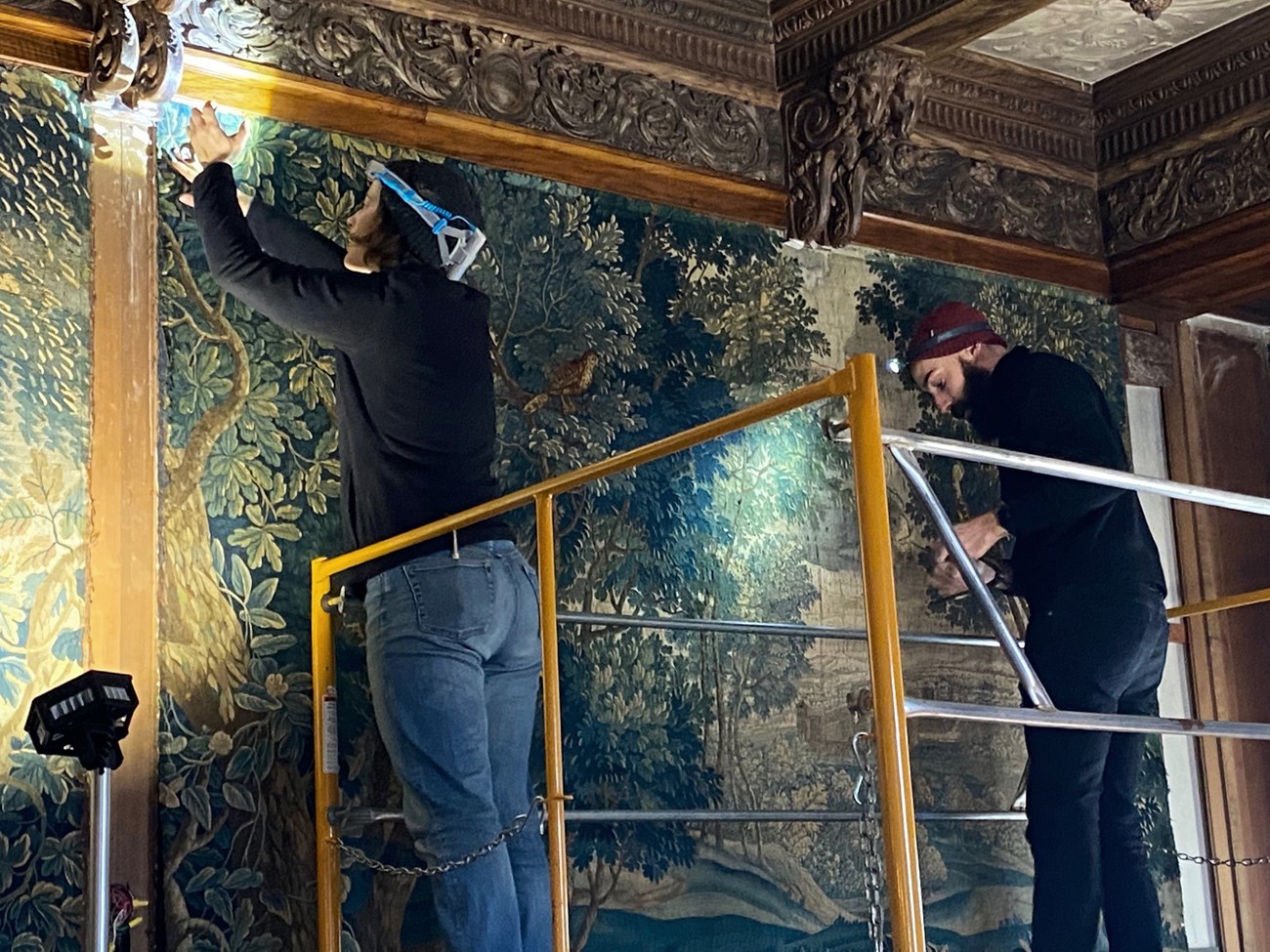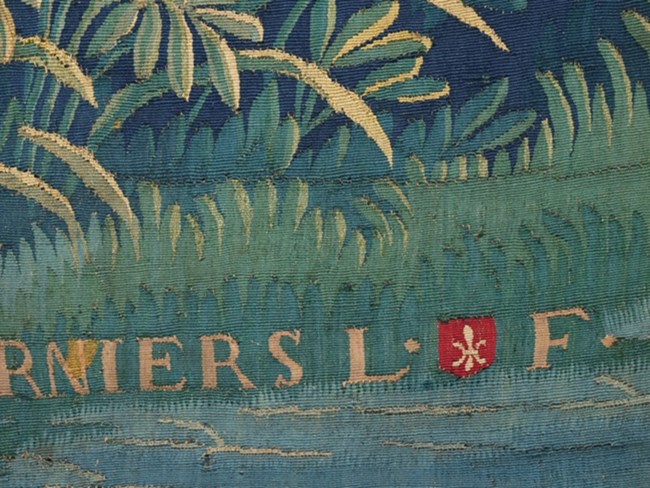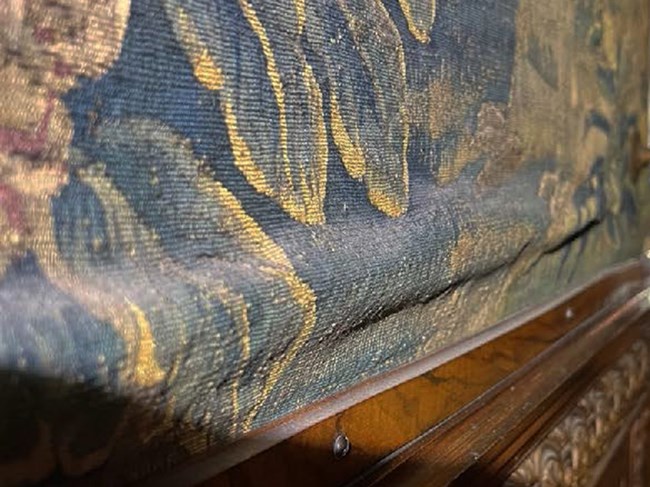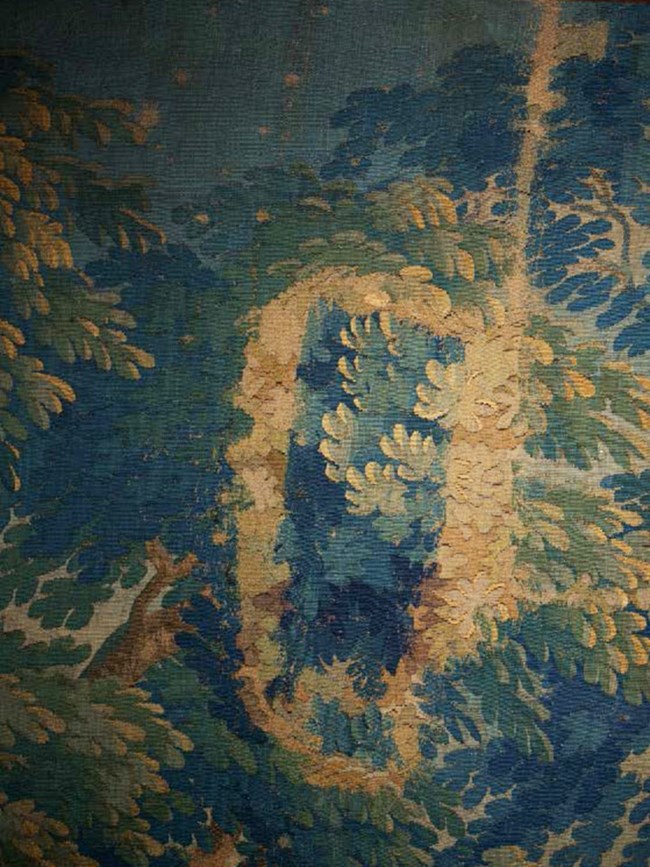Last updated: May 13, 2024
Article
Conservation of Mr. Vanderbilt's Tapestries

Mr. Vanderbilt's bedroom at Hyde Park was designed by French-born interior decorator Georges Glaenzer in a style reminiscent of seventeenth-century Baroque interiors. The prominent and most important decorative features here are the seventeenth-century tapestries that cover the walls surrounding the room.
The wool and silk tapestries are dominated by greens and earthy browns. Hounds, foxes, exotic birds, and birds of prey interact amidst lush greenery and trees of ripening fruit. The foliage and trees frame arcades through which the viewer can see a series of country châteaux, formal gardens, and fountains. Tapestries with scenes set amid gardens and wooded hillsides were known as “verdures” because of their rich green, or verdant, colors. With such deep perspective, verdures like these also created a sense of space within the domestic interior.
During the 1600s and early 1700s, verdure tapestries were most common among Northern Europe’s tapestry weaving industry. These hangings were very popular with prosperous customers who could afford luxurious decor. During the late 19th century, a desire for tapestries continued with America’s wealthy captains of industry who aspired to build their homes in the style of the great country houses of Europe.

This room contains 14 tapestry fragments (some larger, some smaller) fixed and nailed in panel work and covering almost the entire surface of the walls. The tapestries are from two distinctive sets. The first set was woven in the workshop of Guillaume Wernier (d. 1738) in Lille. This attribution is based on the survival of a partial tapestry mark on one of the fragments and an identical but more complete tapestry with the full weaver’s mark that survives in another collection. The second set may have been woven at a workshop in Oudenaarde (Flanders). This attribution is based on two comparable sets of tapestries delivered to the Town Hall of Maastricht in 1705 (five tapestries) and in 1735 (eight tapestries). Without a weaver's mark, it is impossible to attribute these tapestries to a precise workshop.
CONDITION OF THE TAPESTRIES
The silk threads are the most fragile material elements of the tapestries. They are the first to degrade in contact with light and end up being pulverized over time. All the tapestries show areas of weakness in the silks. Some of these degradations are immediately visible and result in silk turning into dust. Other degradations are less visible, with silks in a process of disintegration. These areas are weak because the structure of the tapestry is at risk. If these areas are not consolidated, degradation will quickly appear and gradually spread.
Wool is a stronger and more durable material. The warps and a large part of the wefts are made of wool. There are however weak areas in the woolen wefts of these tapestries. These occur mainly in areas of dark brown woolen wefts, corroded by the use of iron oxide mordants in the historic dyeing process.
If these damaged areas are not sewn again properly, they will create weakness from which the neighboring zones can degrade. Some sewing is not yet damaged, but the tapestries are very fragile—they will break at the slightest movement. It is therefore necessary to sew them again during the conservation work. In some cases, previous sewing is of poor structural and aesthetic quality. It is necessary to remove these old repairs and replace them.

The tapestries are very dirty. This is not surprising, given that the tapestries have probably never been cleaned since their original installation in the room. The dust is particularly visible in certain weaker areas of the tapestries. These areas, more permeable to air, become dirty more quickly. The dust accumulates on the horizontal bulges in the lower area of the tapestries.
For a series of tapestries dating from the end of the 17th century that have been continuously exposed for at least the last 100 years, the colors are relatively well preserved. The green colors have lost some of their yellow components, making the “verdure” tapestries a little bluer than they originally appeared. This is actually a very common occurrence in the colors of tapestries from this period and style.

Beyond the general discoloration typical of historic tapestries, the elements that suffered the most from discoloration are the later fully restored areas. These were most probably carried out using materials dyed with the first generations of synthetic dyes based on aniline derivates. These dyes proved to be very unstable over time and faded much faster than the original colors. Over time, their presence in the weave has become more and more visible. This is especially visible on the west wall tapestries that have been joined together by relatively large areas of re-weaving. The colors of these areas have changed completely to a reddish-brown color making them very detectable.
The most critical condition problems on all tapestries are caused by the way they are hung. The tapestries are stretched in a frame and tacked in place with upholstery nails spaced 2 cm apart. This means that they cannot hang freely. The inevitable vertical elongation over the years results in the formation of bulges in the lower part of the tapestries.
A team of conservators have been selected for this project because of their specialized experience removing tapestries from antique paneling. Each tapestry panel will be carefully removed, rolled on tubes and shipped to the conservation lab for cleaning and repair. The work is anticipated to take 18 months.
